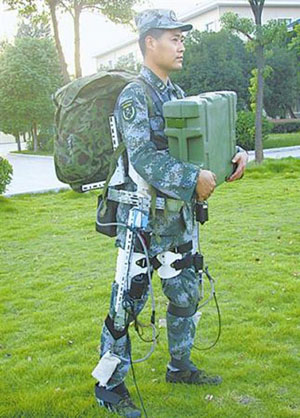China’s military has taken a big step toward fielding the bionic soldiers of comic book fantasies with an exoskeleton suit that multiplies normal muscle strength.
The so-called “iron-man suits” designed by the General Hospital for the Nanjing Military Region gives ordinary soldiers the strength to carry 80-pound boxes as easily as an ordinary backpack, according to a recent piece in the Communist Party organ People’s Daily. The bionic suits, which are worn outside clothing, reduces the pressure exerted by heavy loads on a soldier’s skeletal system by 50%.
The immediate goal for the exoskeleton is to augment the physical strength of PLA troops, enabling them to carry machinery, tools and even munitions. The ultimate goal will be to enhance all the physical capabilities of soldiers, letting them run faster, jump higher and hit harder, according to a Dr Zhou at the Nanjing hospital. He said the exoskeleton will make ordinary PLA soldiers as strong as Tony Stark in his Iron Man suit.
Similar devices are being developed for both military and civilian use in the US and Japan. Lockheed Martin is currently leading a push to develop the Human Universal Load Carrier (HULC), an exoskeleton for the battlefield. It uses battery-powered titanium legs to offset up to 200 pounds of the extra weight of a heavily laden soldier. and allow him to march at 3 mph and even break into a 10 mph sprint for stretches.
Japan’s Cyberdyne is developing the HAL-5 Type-B robot suits for use by workers at the Fukushima 1 nuclear power plant following the March 2011 earthquake and tsunami. The suit is designed to provide radiation shielding while giving their wearers the strength to move about with the additional weight of the shielding. The HAL-5 Type-B is the first personal exoskeleton robot to receive a global safety certificate.
The suits haven’t yet been used at the Fukushima plant but 330 of the full-body exoskeletons have been leased to hospitals across Japan to assist patients suffering from muscle weakness or disabilities caused by stroke and spinal cord injuries.
The suit is billed as the world’s first “cyborg-type robot” because its processors interpret faint electrical signals in the skin around damaged muscles to activate the motorized joints.


